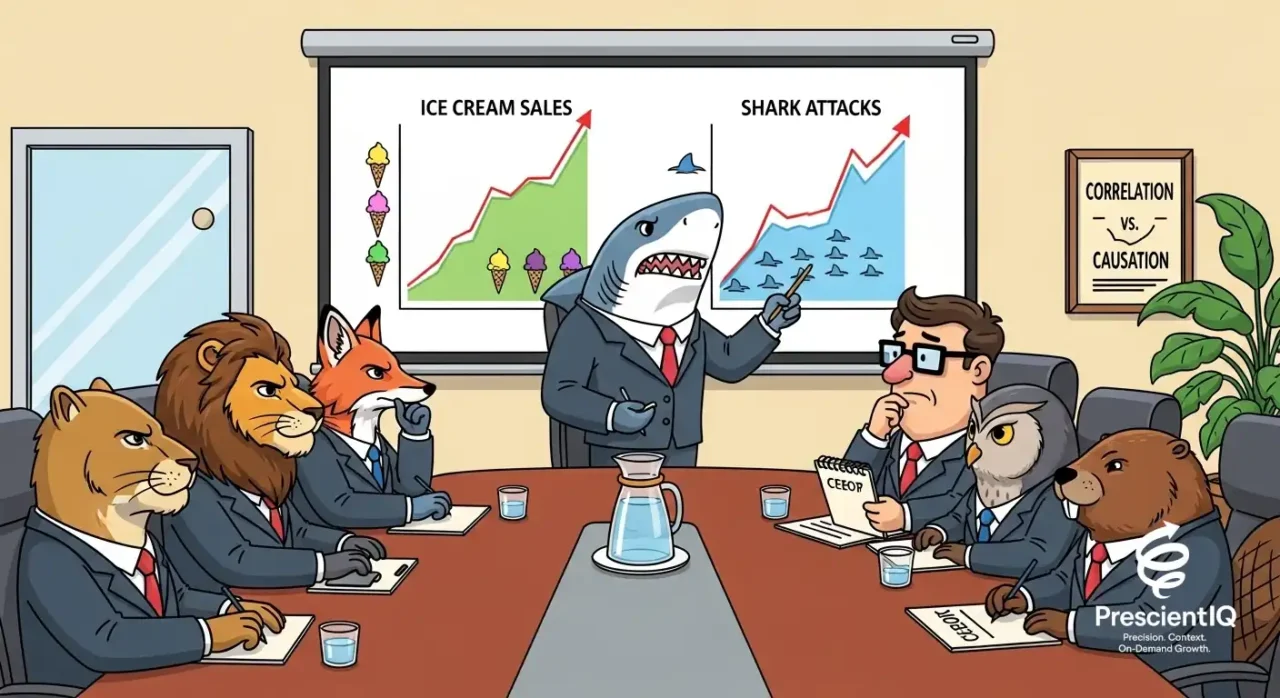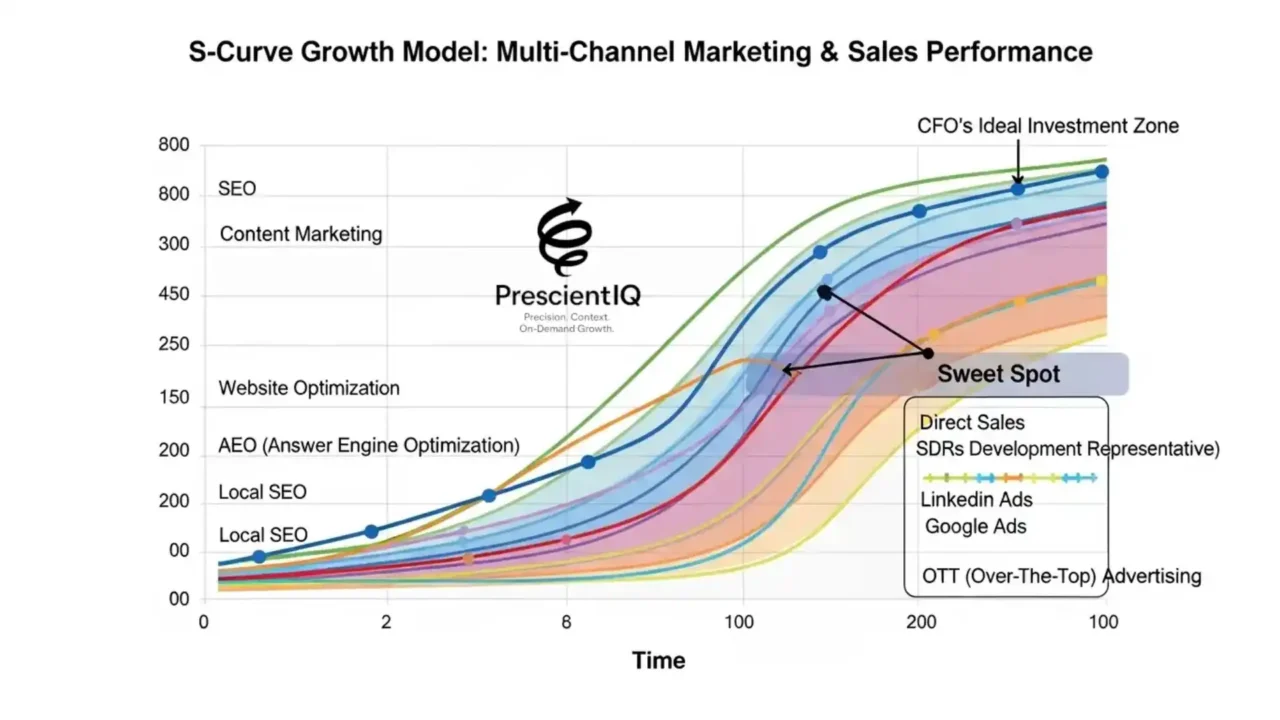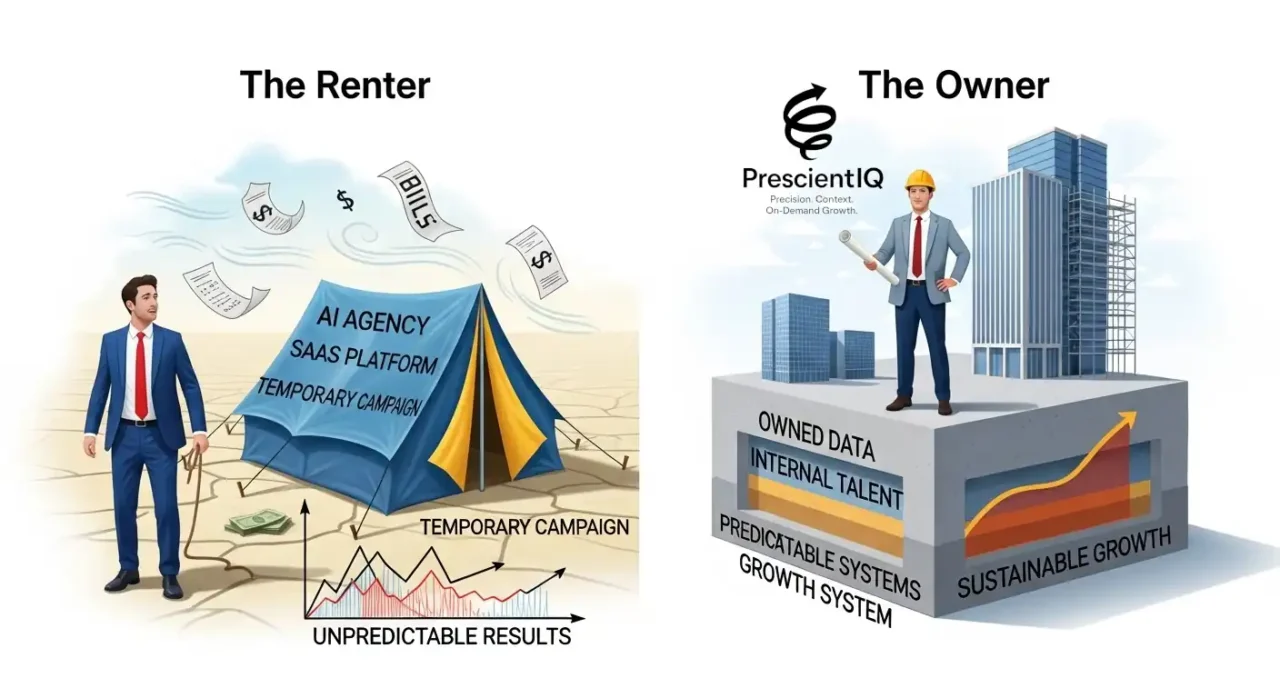When an AI Marketing Agency and Automation Isn’t Enough. Stop Buying Marketing. Install a System for Predictable Growth.
Learn When an AI Marketing Agency and Automation Isn’t Enough. Stop Buying Marketing. Install a System for Predictable Growth.
I. Introduction: The Modern Marketing Trap
A scenario is playing out in boardrooms and on budget calls right now.
A founder, CEO, or CMO is staring at an invoice for $50,000 from their new “AI-powered” marketing agency.
Besides it, they have a report filled with acronyms—MQLs, ROAS, LTV, CAC—and a trend line that looks more like an EKG than a predictable growth curve. They were promised the cutting-edge.
They were told AI would unlock “hyper-growth” and “done-for-you” results. Yet the reality is a high-cost retainer, a “black box” of processes, and a nagging feeling that they are busier managing their vendors than managing their growth.
This is the modern marketing trap. And it’s time to dismantle it.
The lure of AI agencies and sophisticated automation platforms is undeniable.
They promise to be the silver bullet, the shortcut to the front of the line. But this promise is built on a fundamental misunderstanding of what actually drives growth.
The common reality for most businesses is a stack of high retainers, a portfolio of fragmented SaaS tools that don’t talk to each other, and, most damagingly, unpredictable, lumpy results.
You get a good quarter, then a bad one, and no one can truly explain why.
The Core Misunderstanding
The problem isn’t the technology. The problem is the model. For decades, businesses have been taught to “buy marketing.”
We buy ad placements, we buy email lists, we buy “time” from agencies, we buy access to software. We treat marketing as a consumable, a service to be rented, an operating expense to be minimized.
This is fundamentally wrong.
Predictable, sustainable growth doesn’t come from “buying” marketing. It comes from “building” a system. A system is not a campaign. It’s not a vendor.
It is a permanent, internal, company-owned asset. It’s an engine that integrates data, strategy, and execution. You don’t rent the foundation of your office; you own it. You shouldn’t rent your growth engine, either.
Install, Don’t Buy!
To achieve truly predictable growth, companies must stop renting fragmented marketing expertise and disconnected tools.
They must instead install a single, unified system—a “growth engine” that operates as the company’s central intelligence.
This system integrates every scrap of data, learns from every interaction, and executes actions autonomously.
It’s a “Prescient” model of growth, a system that, like PrescientIQ, builds a permanent, internal asset that compounds in value over time.
II. Part 1: The “Why” – When Agencies and Automation Fail

Before we build the new, we must fully understand the flaws of the old.
The current model, a patchwork of external agencies and internal automation tools, is failing businesses.
It’s not because the people are bad or the software is useless. It’s because the architecture is flawed.
A. The Limits of the Agency Model (Even with AI)
The rise of “AI” has given the traditional agency model a new coat of paint, but the chassis is the same. The flaws are structural.
- Misaligned Incentives: An agency is a separate business. It is incentivized to protect its retainer, increase media spend (if it’s paid on a percentage basis), or upsell you to new services. Its goal is to remain necessary. Your goal, on the other hand, should be to build a system that makes the need for that specific agency service obsolete. Their AI is optimizing for their business model, not your most efficient, long-term growth.
- The “Black Box” Problem: The agency runs its “proprietary AI” on your behalf. You get reports, but you don’t get the logic. You don’t own the data models. You don’t own the learnings. If you decide to leave that agency, what do you take with you? Nothing. Your company’s “marketing brain” walks out the door. You are left at ground zero, forced to restart the learning process with a new vendor.
- Lack of Deep Integration: This is the most critical failure. An external agency’s AI is, by definition, external. It cannot be deeply ingrained in your company’s lifeblood. It can’t see your product analytics data to know which customers are seconds away from churning. It can’t tap into your sales team’s CRM to understand the real-time sentiment of a discovery call. It can’t connect to your customer support logs to find the most common complaint from your best customers. An external AI only sees the surface—clicks, form-fills, open rates. It’s optimizing for vanity metrics, not the deep business outcomes that actually create value, like Net Dollar Retention and Lifetime Value (LTV).

B. The Limits of “Dumb” Automation
The alternative for many has been to bring it all “in-house,” but this has created a different kind of monster.
- The “Franken-System”: The average marketing department’s tech stack is a fragile, complex, Rube Goldberg-like machine. You have your CRM (like Salesforce) taped to your marketing automation (like HubSpot), which is duct-taped to your analytics (like Google Analytics), which is wired into your email tool (like Mailchimp), your data warehouse, and a dozen other “point solutions.” This “Franken-system” is a nightmare. Integrations are brittle and break. Data is duplicated, “dirty,” and perpetually out of sync. Your team spends more time acting as IT support and data plumbers than they do on marketing.
- Automating a Broken Process: A fool with a tool is still a fool. Automation without a unified, intelligent strategy just helps you execute bad ideas faster and at a greater scale. If your customer journey is broken, if your messaging is wrong, or if your targeting is off, “automation” is just a way to annoy 100,000 people in an hour instead of 100. It’s spray-and-pray with a bigger hose.
- The Data Silo Catastrophe: The consequence of the Franken-system. Your customer data—your single most valuable asset—is fractured into a dozen pieces. Your product team has product usage data in Mixpanel. Your marketing team has email engagement in HubSpot. Your sales team has call notes in Salesforce. Your finance team has billing data in Stripe. No one has a “single view of the customer.” And if you don’t have a single view of the customer, you cannot possibly personalize their experience. You can’t really do AI. You’re just guessing.
III. Part 2: The “What” – Shifting from “Buying” to “Installing”

The solution is a paradigm shift.
It requires a new vocabulary and a new mindset. We must move from buying to installing.
A. “Buying Marketing” (The Old Model)
- Focus: Activities & Campaigns. The language is episodic: “Let’s run a Q3 ad campaign.” “Let’s launch a new email nurture.”
- Ownership: The agency, vendor, or a fragmented internal team “owns” the process. You rent their time or their software.
- Result: Temporary lifts in metrics. Lumpy, unpredictable results. High dependency on external factors. And, critically, it’s all an Operating Expense (OpEx). It’s a cost that disappears from the balance sheet the moment you pay it.
B. “Installing a System” (The New Model)
- Focus: Building a Permanent Asset. The language is architectural: “Let’s build a data pipeline that scores leads based on real-time product usage.” “Let’s install a feedback loop that connects closed-won revenue back to our content model.”
- Ownership: The company owns the data. The company owns the logic. The company owns the asset.
- Result: Compounding, predictable growth. A store of intellectual property that gets smarter over time. And, most importantly, this is a Capital Investment (CapEx). Like a factory or a piece of proprietary software, it is a company asset with tangible, growing value on your balance sheet.
C. The Goal: Predictable Growth
What does “predictable” really mean? It’s not about knowing you’ll get exactly 117 leads next Tuesday.
It’s about knowing, with a high degree of statistical confidence, that for every $1 you put into your growth engine, you will get $4 out over the next 6 months, within a 10% margin of error.
It’s about being able to forecast revenue from marketing activity with the same rigor as the CFO forecasts operating costs.
This predictability doesn’t come from hope. It comes from a closed, intelligent loop: Act -> Measure -> Learn -> Iterate.
A rented service requires manual intervention at every step. A built-out, installed system does this automatically, 24/7/365. This is where true simulation and AI come into play.
IV. Part 3: The “How” – The “Prescient” System for Predictable Growth

So, what does this “installed system” look like? It’s not just a CRM or another piece of software.
It’s a new “layer” of your business, an intelligence engine built on four pillars.
This is the blueprint for a system like PrescientIQ.
(This outlines the components of an ideal system, using “Prescient” as the model.)
A. Pillar 1: The Unified Data Foundation
You cannot build a skyscraper on a swamp. And you cannot build an AI engine on a “Franken-system.”
The first and most important pillar is a single, unified source of truth for all customer data. This is not just a CRM, which only sees sales and marketing interactions.
This is a complete Customer Data Platform (CDP) that connects all touchpoints, from anonymous to advocate:
- Website/App Behavior: Pages visited, buttons clicked, time on page.
- Product Usage: Features clicked, dashboards created, projects completed, login frequency (this is the most valuable and most often missed data).
- Marketing Engagement: Emails opened, ads clicked, content downloaded, webinars attended.
- Sales Activity: Calls logged, emails sent, meetings booked, contracts sent.
- Support & Success: Support tickets filed, issues resolved, and NPS scores given.
- Finance & Billing: Plan type, LTV, billing history, churn reason.
By unifying this data, you finally achieve the “single view of the customer.” This foundation is the prerequisite for all intelligent action.
B. Pillar 2: The Predictive & AI Engine (The Right Way)
This is the “brain” of your system. But unlike an agency’s “black box,” this is your brain.
It’s trained only on your data, optimizing only for your specific goals. This is where simple “automation” ends and true “prediction” begins.
This engine doesn’t just run on simple “if/then” rules. Advanced systems like PrescientIQ diverge by employing sophisticated modeling techniques such as marketing MCMC simulators.
Let’s break that down. MCMC stands for “Monte Carlo Markov Chain.”
- Markov Chain: This models the customer journey as a series of probable steps. It asks, “What is the statistical probability that a user who visited the pricing page and has logged into the product 3 times will convert to a paid plan in the next 7 days?”
- Monte Carlo: This part runs thousands or millions of simulations of that journey, throwing in real-world randomness (the “Monte Carlo” part). It’s a “what-if” engine on steroids.
Instead of just looking at past data (descriptive analytics), an MCMC simulator runs countless “possible futures” for your entire market to find the highest-probability paths to revenue. It answers complex, high-stakes questions:
- “What is the true profile of our Ideal Customer (ICP), based on LTV and revenue data, not just job titles?”
- “What is the actual likelihood this new lead will buy? What is their predictive lead score?”
- “Which of our current customers are at high risk of churning in the next 90 days, and what one action can we take to save them?”
- “Which ‘free’ users are showing the exact behavioral signals that preceded our last 100 major enterprise upgrades?”
This MCMC-powered engine, built on your unified data, is what PrescientIQ uses to identify your true ICP, to power a predictive lead score that actually predicts revenue, and to spot churn and expansion opportunities before a human ever could.
It moves your marketing from guesswork to applied data science.
C. Pillar 3: The “Playbook” Orchestrator
If Pillar 2 is the brain, Pillar 3 is the central nervous system. It acts. This is the “automation” layer, but it’s intelligent, not “dumb.”
It doesn’t run on simple triggers like “form filled.” It runs “plays” based on the AI engine’s predictive insights.
A “dumb” automation says: “IF user downloads ‘X’ whitepaper, THEN send ‘Y’ email.”
An intelligent playbook says: “IF a new lead matches our 95th-percentile ICP model, AND their predictive lead score is > 90, AND they have logged into our free product and used ‘Feature X’ twice in 24 hours… THEN:
- Instantly add this user to a hyper-specific ‘Lookalike’ ad audience on Facebook/LinkedIn.
- Simultaneously send a plain-text, hyper-personalized email from their assigned sales rep (not ‘marketing@’).
- At the same time, create a ‘High-Priority’ task in that rep’s CRM with the full context of the user’s behavior.
- AND send a ‘Congrats’ message to the internal sales-team Slack channel.”
This is cross-channel, cross-departmental orchestration, triggered not by a single action, but by a high-probability moment identified by the AI.
D. Pillar 4: The Closed-Loop Feedback Mechanism
This is the most crucial pillar. This is what makes the system a compounding asset. The system must learn.
When a sale is marked “Closed-Won” in the CRM, that “win” data (and the revenue amount) is fed all the way back into the AI engine.
The system now knows: “The combination of behaviors and attributes that led to this predictive score worked.” It reinforces those patterns in its model.
Conversely, when a lead marked “predictive score 95” tells a rep, “I’m not interested,” that “Closed-Lost” data is also fed back.
The system now knows: “My model was wrong. Why?” It re-weighs its parameters. It learns. It gets smarter.
This closed-loop feedback mechanism connects all revenue back to the first marketing touchpoint.
It means you can finally, definitively, answer the hard questions:
- “What is the exact ROI of Blog Post Y, not in ‘views,’ but in ‘closed-won revenue’?”
- How many users started their journey by discovering us on our mobile app and completed their purchase 3 days later on our desktop website?
- “Which ad creative actually leads to high-LTV customers, not just cheap clicks?”
- Which of my current users are most likely to ‘churn’ (stop visiting) in the next 7 days, and which are most likely to make a purchase?
- What was the complete user journey for all my visitors from Germany, including those who did not consent to cookies?
Your growth engine gets smarter every single day, every single hour. It is a true learning system.

V. Conclusion: Become the Owner, Not the Renter
The current model is broken. We are paying for temporary access to someone else’s tools, platforms, and talent.
We’re getting a “sugar high” from a good campaign, but we’re not building the “sustainable health” of a predictable growth system.
The agency model is a dependency trap. The “Franken-system” of disconnected tools is a data liability.
It’s time for a new model. It’s time to stop renting and start owning.
The path to installing your own growth engine isn’t a quick fix, but it starts with a few simple steps:
- Audit Your Data: Where does it live? Who owns it? How disconnected is it? The first step is admitting you have a “Franken-system” problem.
- Map Your Customer Journey: Really map it. Identify every touchpoint, from the first ad click to the renewal invoice. See where the data lives at each step.
- Ask the Hard Question: “If I fired my marketing agency and canceled my top 5 SaaS tools today, what would I be left with?”
If the answer is “nothing but an invoice,” it’s time to build.
Don’t buy marketing. Build a system. Don’t rent a “black box.” Install an engine. Build a “Prescient” model of growth like PrescientIQ, and for the first time, you will truly own your future.
Generate an image in a modern, clean, editorial illustrative style (similar to tech websites or business publications). The scene should visually represent “The Modern Marketing Trap.”
- Central Figure: A frustrated and confused CEO (in modern business attire) scratching their head.
- The “Trap”: The CEO is standing in front of a large, sleek, glowing “black box” labeled “AI HYPER-GROWTH ENGINE”.
- The Cost: A thick, expensive-looking cable labeled “$50,000 RETAINER” plugs into one side of the box.
- The Results: On the other side of the box, a digital screen displays a chart labeled “PREDICTED GROWTH”. However, the trend line is a chaotic, unpredictable EKG-style scribble, not a smooth upward curve.
- The Confusion: Floating in the air around the CEO are faint, distracting acronyms like “MQL,” “CAC,” “LTV,” and “ROAS.”
- The Feeling: The overall tone must be one of high cost, complexity, and a complete lack of control or understanding.
The Correlation-Causation Fallacy
Why “Ice Cream” doesn’t cause “Shark Attacks”
1. The Problem: Correlation
During the summer, two things increase at the same time:
These two trends are CORRELATED.
2. The Fallacy: False Cause
A purely correlation-based AI (or a human!) makes a logical error:
“If A and B happen together, A must CAUSE B (or B causes A).”
3. The Reality: Hidden Cause
There is a third, “confounding” variable that is the *actual* cause of both trends.
The Takeaway
Correlation does NOT imply causation. Just because two things trend together does not mean one causes the other.
The AI’s “solution” (e.g., banning ice cream to prevent shark attacks) would be absurd and useless because it targets the correlation, not the true cause. Effective problem-solving requires finding the real causal mechanism.


